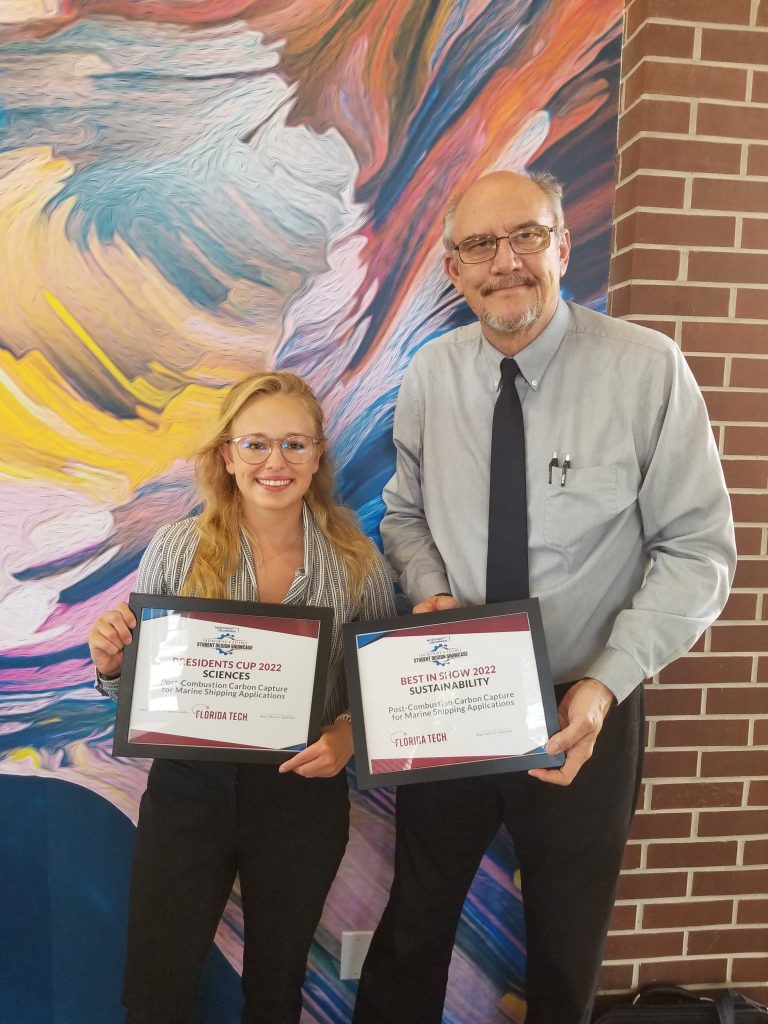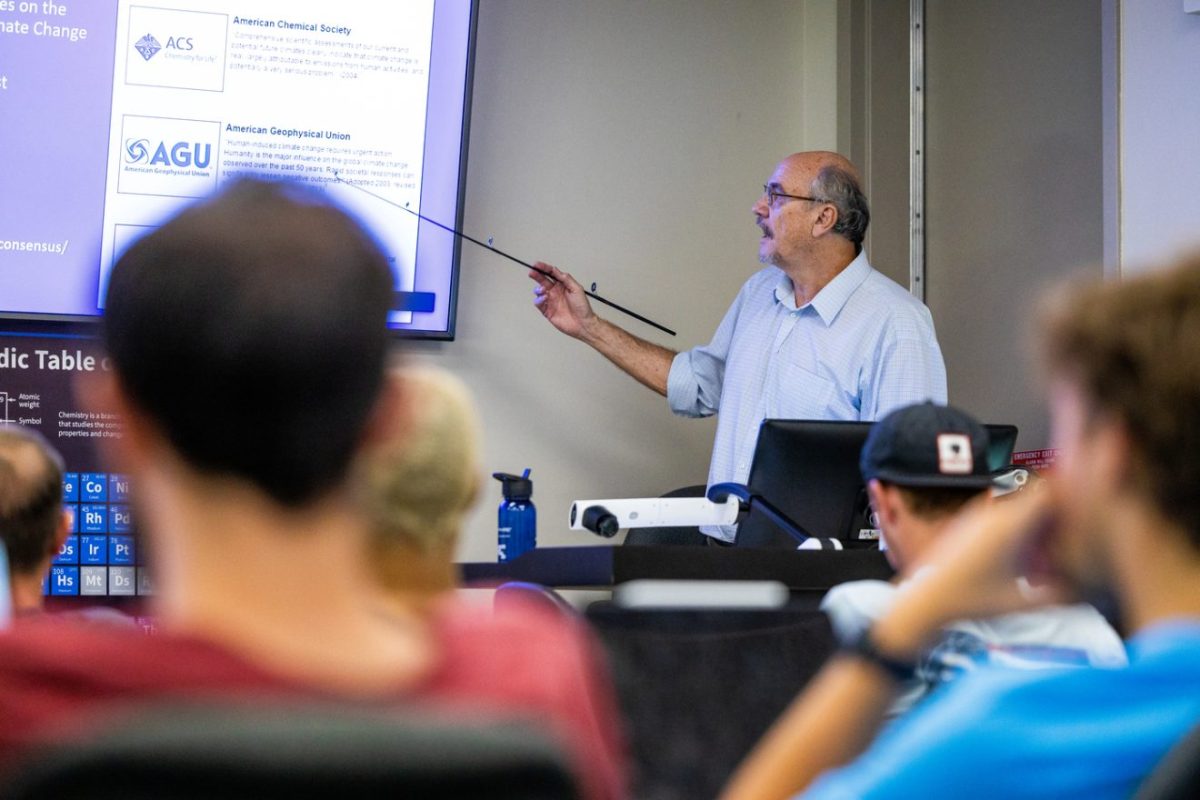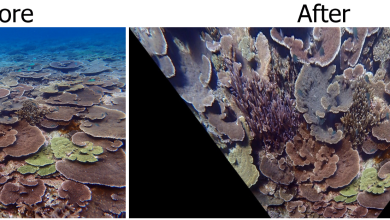Ken Lindeman, Father of Sustainability at Florida Tech, Retires After 17 Years
Nature’s finest handiwork was Ken Lindeman’s companion.
The waters of Chesapeake Bay, the ocean ecosystems of Oahu, Hawaii, the coastal estuaries around Jupiter, Florida—wherever he was during his early life, his connection to such areas of beauty and complexity grew, as did his interest in the science behind them.
From an early age, he says, “the science was always there.” It was arm-in-arm with curiosity.
His eyes wide open, his observations already keen, Lindeman also saw countervailing forces touch his surroundings, both outside and in.
He saw development encroach on these natural areas, now corralled and controlled in the name of growth.
He saw his mother, the Kentucky-born athlete and gifted golfer Mary Lee Lindeman, limited as she tried to make her way in professional golf in the 1960s. He saw her denied teaching positions at golf courses and country clubs that were given to less-qualified men. During his teenage years in Hawaii, he lived among many cultures and was fascinated by this human diversity.
All of this helped shape Lindeman. It motivated him over the next 50 years to become a scholar and researcher, a teacher and mentor, an activist and leader, and to apply the science he learned to the environmental challenges he wanted to solve.
This journey has unfolded at Florida Tech for the last 17 years, an institution now home to one of the strongest STEM-based sustainability programs in the southern U.S. thanks to Lindeman’s unfailing stewardship and near constant work.
The program goes on, but Lindeman no longer drives it. Retirement beckoned, and it became official after fall commencement in mid-December.
“I need to decompress for a few months at a minimum,” the 65-year-old says. “There’s a lot of family stuff. I know that I will keep trying, but not weekly in front of 20-year-olds as much. That’s what you do when you retire.”
A Science Kid
Arthur Lindeman was a U.S. Military Academy graduate and decorated Army Ranger who served in Korea and Vietnam, and his family moved as military families do. So that meant his son Kenyon—most called him Ken—ended up in diverse places where nature was accessible. The young man developed what he called “ocean connections.”
“I was fortunate to experience some truly extraordinary coastal and ocean ecosystems growing up,” Lindeman says.
And if he wasn’t exploring, he was likely reading: encyclopedias, books on science and marine life and other treats unearthed among the stacks.
“I was riding my bike to the library to read books about seashells and other mollusks, and there’s a lot of kids like me. I was just a nerd.”
Lindeman lived in Hawaii for several years, including his first two years of high school, and his ocean connections deepened. He started surfing there, and as a high school freshman earned his first scuba certification with a check-out dive off the north shore of Oahu.
In 1974, while Arthur was serving at Schofield Barracks in Oahu as a lieutenant colonel, he suffered a massive stroke with partial paralysis and the loss of speech for years.
Arthur spent almost a year in the hospital, and in 1975 the Lindemans moved to Jupiter, Florida, a short drive from where Mary Lee’s sister lived in North Palm Beach. It was Lindeman’s first exposure to the Indian River Lagoon, at a time when it was far less developed—and damaged—than it is today. There were still dirt roads in the area, he recalls.
Seeing the booming development over the ensuing years and how the land and lagoon suffered under this growth was galvanizing for Lindeman. “There was never any question about making serious efforts to apply science and scientific discoveries to real-world environmental problems,” he says.
The Loxahatchee River and the nearshore ocean dazzled him with its generally clear water ready to offer opportunities for offshore scuba diving. Still, it took until the end of high school for Lindeman to settle, at least at that time, on a career in science, not law. It was an internal debate that he would have again, this time as a newly minted undergraduate from a university located about 100 miles due north.
Florida Tech to Miami to Florida Tech
Lindeman’s love of marine science grew in high school.
“When I graduated high school, I just was very ocean infatuated and very science infatuated,” he says.
A Florida university was on his radar. It offered an undergraduate degree in oceanographic technology, which was not all that common back then, and a satellite campus in Jensen Beach, literally up the road from Jupiter.
But as he did at the start of high school, Lindeman still thought about studying law. “What I realized is that you can do a lot of things as a scientist that involve the law and policy,” he says.
That vision would spark Lindeman to start a nonprofit years later, but for now, it was time for college. Lindeman enrolled at Florida Institute of Technology in 1976 and began classes at the Jensen Beach campus. He opted to major in biological sciences. The experience there was “amazing,” he says, but seeking more emphasis on his schooling, he transferred to the school’s main Melbourne campus ahead of his sophomore year.
Graduating in 1980 with his bachelor’s degree, Lindeman headed south again in 1981 – not to Jupiter but to Mayaguez, Puerto Rico, for a master’s degree from the department of marine science at the Universidad de Puerto Rico.
The facility he developed with the Spanish language would be put to good use.
After graduating with his master’s degree in 1984, Lindeman returned to the Sunshine State. He had been accepted as a Ph.D. student at the prestigious Rosenstiel School of Marine, Atmospheric, and Earth Science at the University of Miami, where he would later earn his doctorate.
Several important developments occurred early in the nearly two decades Lindeman was living in Miami. First, he would meet a cockpit flight engineer named Beth Schoppaul whom he would later marry and have two sons with. They will mark 30 years together in February.

“I could have done little without my incredible wife and children,” Lindeman says, including two sons from a previous marriage. “The kids also taught me more than I could even begin to describe.”
In the meantime, however, Lindeman was going to do some teaching on his own. His first time in a classroom as an instructor, not a student, happened at St. Brendan High School in a west Miami neighborhood. It was 1990, and he began teaching six classes per day to help pay for his Ph.D.
But teaching was not all Lindeman would do in Miami. He also co-founded a small nongovernmental organization (NGO) in 1990, Coastal Research & Education, where he was executive director until 2000.
Additional research and policy needs beckoned, including a growing portfolio of coastal environmental work with organizations such as the South Atlantic and Caribbean Fishery Management Councils and consulting with several NGOs.
In 2000, Lindeman departed for another outstanding opportunity to serve as senior scientist for the Environmental Defense Fund’s Caribbean Program. There, he was involved in conservation projects centered on research and community outreach on fisheries, nearshore habitats and marine protected areas in the southeast U.S., Mexico, the Greater Antilles and elsewhere.
Now experienced in many aspects of applied conservation science and what these challenges meant to the people affected by them, Lindeman was more aware of the broad scope of sustainability: “It’s not only about pandas and rainforests. It’s also about making things work better for humans and their economies, as well.”
As the family’s time neared 20 years in Miami, the city’s growing popularity was evident, its energy often electric. But the crowding was increasingly challenging, as was the drive to get to the ocean.
They enjoyed areas of the city and loved that it was bilingual and humming with South American flair, but with middle school looming for their youngest children, and other reasons, it felt like a good time to look around.
So where to go? Linderman considered the move an opportunity to get to a place that maybe, eventually, would allow him to slow down a bit. It was with that in mind that he thought, “Maybe we can live near the ocean, and I could get a job at Florida Tech?”
In 2005, the Lindemans moved to Satellite Beach.
Teaching Sustainability
Lindeman’s arrival at Florida Tech was a low-key affair.
Work for the Environmental Defense Fund concluded in 2007 and Lindeman reconnected with George Maul, who like Lindeman, was a graduate of the University of Miami’s Rosenstiel School.
A departing faculty member in what was then the Department of Marine and Environmental Systems, which Maul was leading, provided an on-ramp. Lindeman received the Henry L. and Grace Doherty Visiting Professorship and taught graduate classes in coastal systems management and marine protected areas.

By 2009, some Florida Tech leaders were considering a potential academic program centered on sustainability.
What is sustainability? Lindeman describes it this way: using resources in the present so that future generations will have the same resources available to them.
It is a simple concept but one that fans out across many fields and disciplines, something Lindeman appreciated and understood deeply. When Florida Tech opted to create a sustainability minor, it had to have interdisciplinary outreach and a leader who could carry that out.
“Ken had a good background, and he had the ability to interact with a variety of disciplines both with students and faculty,” says Gordon Nelson, professor emeritus and dean of the College of Science when Lindeman was hired. “Sustainability is technology, economics, and social welfare. All have to be present.”
Launched in 2010, the sustainability studies minor quickly became one of the most popular minors at Florida Tech. It attracted students from across the university and across disciplines. The minor carried with it, until recently, a required senior capstone project, and it is not unusual to see students from engineering working with those from psychology and those from business.
“There was little precedent for that,” Lindeman says. “We had business students presenting posters at our Northrop Grumman Engineering and Science Student Design Showcase.”
More than 30 majors from all colleges are represented among Florida Tech students who have graduated with a minor in sustainability studies.
“Ken has done a lot and has positioned Florida Tech well in sustainability,” Nelson says.
Dozens of students have now graduated with a STEM-based major in sustainability. Lindeman developed that program, too, and it launched in 2014. All told, there will be more than 190 graduates with the Bachelor of Science degree or the minor by spring 2024.
“Ken Lindeman has been the life-blood of Florida Tech’s sustainability programs,” says Richard Aronson, professor and head of the department now called ocean engineering and marine sciences, where Lindeman was based. “He has single-handedly run the academic side of sustainability for many years and worked with Facilities to green the campus. His will be large shoes to fill.”
The Importance of Interdisciplinary
The word “interdisciplinary” has been used for decades in academia and increasingly in business. It is the North Star in Lindeman’s classroom.
“You can talk that talk, and you can walk that walk, and our sustainability program here has always been about trying to convey excellent information on the talking side, and to provide extraordinary, truly interdisciplinary experiences on the walking side.”
That walking side is what dazzled ocean engineering and sustainability studies minor alumna Alice Pennings ’22 ’23 M.S.
“He leads by example, both in the classroom and in his community. He expected a lot from his students—as many professors at Florida Tech do—but he always matched and exceeded those efforts in return,” she says.
What truly made an impact on her views on sustainability and the environment was seeing what Lindeman did outside the classroom, such as his work on area boards and with local cities.

For example: he will be recognized in February with a proclamation from the Town of Indialantic, where he and several sustainability students have worked for years on its sustainable action plan. The proclamation reads, in part, “that this proclamation be duly executed and presented to Dr. Ken Lindeman as a token of the Town of Indialantic’s acknowledgment of the impact his expertise has had in guiding the town towards a more sustainable future, leaving an enduring legacy for generations to come.”
“He showed that, to inspire real change, there requires a blend of scientific research, a constant push for policy change, community outreach, and volunteer work,” Pennings says. “I had previously seen my purpose in the world of sustainability to be purely scientific. I learned that that is just the tip of the iceberg, and one person can—and should—wear many hats to work toward a more sustainable future.”
Other students shared similar sentiments, saying learning the systems science Lindeman teaches makes them better applied thinkers and problem-solvers.
“That is foundational to tackling hard sustainability problems,” Lindeman says.
“We’re very solution-focused in these classes, always have been,” he adds. “I think an important part of the teaching experience and the learning experience for the students is you learn and apply a tremendous amount of key information.”
That learning will go on. Sustainability courses will be taught. But for the first time, they will not involve Ken Lindeman. For the first time, he will not be at the head of the classroom using a fishing pole as a pointer and speaking with passion, his voice louder or quieter for emphasis, his demeanor serious but supportive.
Over the years he has debunked climate myths and connected the dots, always seeking to empower his students, to equip them to see clearly in a world that can be muddled—and to help that world do better. All is not lost, he counsels, despite rising pessimism.
“Humans fix things,” he says in one class.
Now What?
Retirement does not mean stagnation for Lindeman. But a slowing down is not unwelcome. Emailing into the evening, working on weekends—he has experienced decades of that.
He is excited to focus on his non-academic pleasures: his family first and foremost, but also his other lifelong friend, the ocean. He visits in twilight, drawn to the changing sky and shifting winds that accompany those times.
He may have a book or two in him, to build on several others. He will consult and continue to share his expertise.
He will not teach, at least for now. “I don’t think I’m going to need that feeling for a while. I’ve done it full-tilt and I think I’m not going to need that.”
But never will Lindeman stop caring about and working for the natural world.
“I was trying to save things before I had kids but for my kids, because it made sense. We’ve got to get busy. We’re still behind.”





